Visit a public shooting range and it becomes apparent that the M16 platform has successfully made the transition from military weapon to serving the public as a means of recreation as well as home defense in the form of the AR-15 semi-automatic. Accordingly, model development for this platform continues apace, so in this article well consider three new carbine-length AR-15s in 5.56mm NATO and 300 Whisper. Our first two AR-15s were chambered for 223 Remington or 5.56mm ammunition, by far the most popular calibers for the AR.

They were the Mossberg MMR Tactical Rifle (w/sights) and the Olympic Arms K3B-M4-TC-M4 Tactical Carbine, which Oly calls the alphabet gun for obvious reasons. Our third test gun is Smith & Wessons M&P15 300 Whisper, which stands out because it uses magazines interchangeable with the 223/5.56mm models but fires 30-caliber bullets. Our previous test of a 300 Whisper AR-15 featured a carbine directly from SSK Industries, the home of 300 Whispers inventor, J.D. Jones, (SSKIndustries.com). The Smith & Wesson M&P15 300 Whisper is, to our knowledge, the first production model of this chambering from a high-volume major manufacturer. Mossberg is another volume manufacturer, but the MMR is the companys first production-model AR-15.
To establish accuracy data, we visited the 100-yard range at Houstons American Shooting Centers, (AMshootcenters.com). To determine muzzle energy, we utilized an Oehler chronograph to measure velocity so we could enter it into the appropriate equation: Does computation of muzzle energy truly measure stopping power? Not necessarily, but it does provide a reliable indicator of the amount of force the projectile starts out with, just like MSRP (Manufacturers Suggested Retail Price) indicates possible retail pricing.
Test ammunition for our 223/5.56mm guns featured the three most popular bullet weights. We fired Sellier & Bellot 55-grain FMJ rounds, and two selections manufactured in Rapid City, South Dakota, by Black Hills Ammunition. They were the 60-grain V-Max and the 69-grain OTM. The Black Hills OTM (Open Tipped Match) rounds were marked 5.56mm NATO while the other rounds were designated 223 Remington. To test our Smith & Wesson rifle, we chose 208-grain Hornady A-Max and Hornady 110-grain V-Max 300 Whisper ammunition. Plus, we shot Remington 125-grain Accu-Tip rounds marked 300 AAC Blackout.
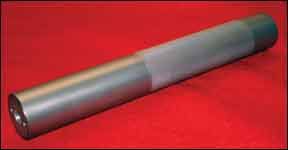
We should note that the use of names other than 300 Whisper was reportedly an attempt to avoid the expense of paying royalties to its inventor. This practice appears to be fading out. That Smith & Wesson lists 300 AAC Blackout only as a co-chambering but chose to designate this rifle as the M&P15 300 Whisper tells us that the Whisper name will win out.
Optics for our bench session consisted of the same Burris Xtreme Tactical 6-24X50mm with Mil-Dot reticle on each rifle (previously tested in our May 2011 issue). We also tried the new Brownells CQB T-Dot holographic sight by EOTech for offhand shots ($549, from Brownells.com). This scope provided a hologram-style projection that offered a large circle surrounding a central dot for zero and a second dot for hold over to extend aim to additional points of elevation. The CQB T-Dot can be used as a standalone sight or in co-witness with iron sights. An outer shell provided impact protection and a quick-release mounting system. This type of sight is a popular add-on, and we wanted to know how our test guns would accommodate this system. Our team of test shooters included a highly ranked High Power competitor and a third generation United States Marine recently discharged and now serving in law enforcement. Lets see how each of our AR-15s performed.
Mossberg MMR Tactical w/Sights No. 65014 5.56mm NATO, $950
The AR-15 is in some quarters referred to as an MSR, or Modern Sporting Rifle. Mossberg offers another acronym, MMR, meaning Mossberg Modern Rifle. Youll notice our test gun was the Tactical w/sights, but it can also be purchased without sights. Further testament to the modular approach is that the same central operating system (receiver, trigger, reciprocating bolt, etc.) can be surrounded by a 20-inch barrel and a fixed rifle stock of traditional A2 configuration for the same price. This would be the Model No. 29100, which is referred to as The Hunter. The magazine supplied for the Hunter packs only six rounds of 223/5.56, while the MMR Tactical arrived with one 30-round magazine.
Just because our test gun was designated as being Tactical rather than as a Hunter doesnt mean it cant be used for hunting. In fact, the Tactical would probably be the preferred model for hunting pigs, which is a popular target for both sport and pest eradication. Our MMR featured a four-surface rail system on its handguard, which pig hunters commonly use to attach lights and lasers. A rail-mounted vertical forend grip is another popular accessory. The vertical grip comes in handy when bracing for a shot using the cross bar on an ATV, a popular conveyance for pig hunters. The shorter barrel and six-position collapsible stock also comes in handy when traveling through brush and woods.
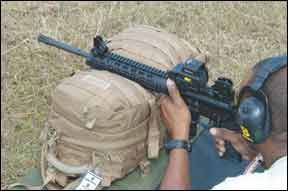
Basic construction of the MMR was typical. It had a 1:9-inch-twist barrel measuring little more than 16.0 inches long, and its adjustable stock produced an overall length of about 33 inches to 36 inches overall. There was a solid-mount non-rotating sling loop attached to the bottom of the buttstock, but no corresponding loop up front. Normally, the forward attachment point would also be a loop or stud attached to the front sight/gas block. But the MMR was upgraded to a four-point rail that was free-floated from the action. An additional component that adapts a sling stud to the bottom rail would have to be purchased separately, but the benefit of the free float was that stress from the sling would be isolated from the barrel. The supplied sights bolted on to the Picatinny rails fore and aft, with the rear unit supplying both windage and elevation adjustment. The front unit was constructed in the triangular gas black design, which provided both strength and protection for the front-sight blade, which was height-adjustable by one-quarter turns.
Along with many features standard on the AR-15, such as a flash hider, left-side safety, and right-side magazine release, was an original-design pistol grip. Fashioned from polymer, we found it offered a comfortable and highly functional grip surface. The grip was hollow and capped by a rubber plug that offered two six-sided holes that could tightly grip a pair of AA-size batteries. The grip was bolted on at the standard position from the top of the grip, but its profile extended to complete the trigger guard as well. The result was an enlarged opening to accommodate a heavily gloved finger. The trigger guard bypassed traditional design wherein the lower edge swings away for greater access. Another traditional feature that was left out was the forward assist plunger for the bolt. Were split on this matter, but many builders and practitioners feel the forward assist is obsolete.
With the naked eye, it was apparent that the Picatinny rail machined atop the receiver was not in line with the rail atop the forend. We could only measure a mistake of about 0.025 inch, but looking through the supplied sights only made it more obvious, as did an attempt to co-witness the Brownells CQB T-Dot. There are two ways to overcome this. One is to mount a long relief scope (1X power or otherwise) on the forend rail and live with the offset cant, which will probably go unnoticed, especially when firing off hand. The other is to mount all optics on the receiver only and relegate the forend rail to supporting only lights and lasers.
At the range the 6-pound trigger seemed heavier than necessary, but it was grit-free and predictable. The Mossberg MMR Tactical clearly favored the 60-grain V-Max rounds, producing a 0.8-inch five-shot group on its way to posting a 1.0-inch average.
Neither the 69-grain nor the 55-grain rounds delivered a single sub-minute of angle group. Five-shot averages measured 1.7 inches and 1.4 inches wide respectively. Reliability was 100 percent, but when compared to the Olympic Arms AR-15, velocity was down by about 92 fps on average.
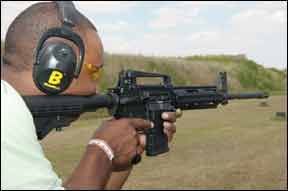
Our Team Said: When it comes to the basics, we think Mossberg got it right (unless you prefer a forward assist). But our MMR had an misaligned rail that made this upgrade less valuable and put the supplied sights on the shelf. Thats a warranty fix, but just imagine how much more affordable this gun would be without the railed handguard. Itd be hard to pass up. The suggested retail price may be a little high, but guns from volume makers usually sell for less than their competition. That makes the MMR worth a long look, in our view.
Olympic Arms K3B-M4-A3-TC-M4 Tactical Carbine 223/5.56mm NATO, $1246
Based in Olympia, Washington, Olympic Arms sells pistols as well as rifles and carbines based on the AR-15 platform. Our alphabet gun, as they refer to the K3B-M4-A3-TC-M4, was a bit of a mix. It had a flattop-rail receiver and a short 7.1-inch alloy handguard that was heavily vented and machined with four low-profile Picatinny rails. Alignment with the receiver rail was close if not perfect. It was hard to compare with the naked eye because the rail atop the receiver was full bodied, but the rails on the forend were relieved in the center. But after mounting the supplied bolt-on carry handle with fully adjustable rear aperture, the sights appeared to be in line.
With the exception of the railed handguard, this carbine appeared to be a standard build. The plastic pistol grip was the most basic part, with moulded checkering, a single finger groove, and some rough edges at the seams and molding points. The bottom of the trigger guard was held by a spring detent pin and was capable of swinging out of the way to make room for greater access, such as when wearing heavy winter gloves. Finish was Parkerizing on the barrel and a black matte anodization on the receiver. It had a triangular gas block with elevation-adjustable front sight post. Beneath the gas block was a sling loop hinged for front to rear action only. The six-position buttstock had a solid-mount sling loop, but its seating was much looser than we think it should have been. It was apparent, however, that extra time had been put into refining the trigger. Of our three test guns, the 4-pound trigger on our alphabet gun was the only one that we wouldnt flag for further adjustment. Its takeup was just long enough to prevent us from using the word crisp, but we thought it presented a very good balance of safety and precision.
When mounting the Burris scope, we were limited by the structure of the gas block. Not able to mount the scope as far forward as we would have liked, this negatively affected eye relief. We added material to the buttpad to compensate. The design of the railed handguard may be a matter of taste, but we think a railed gas block would have made this weapon more versatile and more in line with the price. Our CQB T-Dot sight proved too tall to co-witness with the supplied sights.
From the 100-yard bench, our Olympic Arms carbine delivered a single best group of Black Hills 60-grain V-Max ammunition measuring 0.6 inches center to center. But, on average, the Olympic trailed the Mossberg MMR by one tenth of an inch. The Olympic did, however, like the 69-grain OTM rounds better than the MMR, producing five-shot groups that printed in a very narrow range, varying as little as 1.2 inches to 1.4 inches across. Performance firing the 55-grain rounds was lackluster, measuring about 1.8 inches across on average. But velocity and power produced by the Olympic Arms Tactical Carbine was nearly 100 fps greater on average for all three test-rounds than readings produced by the Mossberg. This was probably due to a tighter chamber.
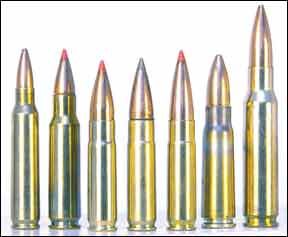
Our Team Said: One of the criticisms heard from our staff was the plain, if not stodgy, components. The pistol grip, buttstock, and gas block were closer in appearance to being surplus than factory fresh, in our view. The finish was rudimentary, and the handguard had an air of obsolescence. There are just too many other good AR-15s chock-full of features in its price range for us to buy this gun.
Smith & Wesson M&P15 300 Whisper No. 811300 223 Rem/5.56mm NATO, $1110
One of the ways in which the AR-15 platform is redefining its role is availability in additional chambering more appropriate to hunting. Like the M16/AR-15 platform itself, the 300 Whisper was developed first for military use, specifically for use with suppressed barrels. The desire was for a 30-caliber round that could be adapted to the lighter 5.56 receiver and produce greater stopping power. Sound suppression was part of the deal so that the weapon could be used in close quarters, especially during the type of door-to-door entries that are so much a part of current warfare. That suppressors are now legal for hunting in many states adds to the appeal of 300 Whisper and its identical twin, the 300 AAC or 300 Blackout.
The M&P15 300 Whisper offered a striking appearance thanks to its Realtree APG camouflage coating. The pistol grip, six-position buttstock, and receiver (including the top rail) were camouflaged. So was the plastic A2 handguard. The buffer tube, barrel, and rail-topped gas block with sling loop, ejection port cover and other small parts were coated with black Melonite. A black tactical upper, full float with four-sided rail, No. 812012, $819, is also available. But our test rifle offered no visual cue as to the chambering. The barrel carried an A2-style flash suppressor, (threading was 5/8-24). Even the 10-round supplied magazine was topped with an orange color follower stamped 5.56.
At the range we thought the trigger-pull weight of 7.5 pounds was excessive, but there wasnt any grit or creep in the trigger either. We liked the quick-release spring-detent sling loop beneath the gas block because it swiveled 360 degrees and could be replaced with a similar quick-release sling stud for attaching a bipod. The underside of the block also offered a threaded hole for attaching a standard-thread sling stud. The Picatinny rail gas block affords the option of mounting a front sight, light, or laser and it wont get in the way of mounting more powerful scopes such as our Burris. The A2 handguard is still the most comfortable to hold, in our opinion.
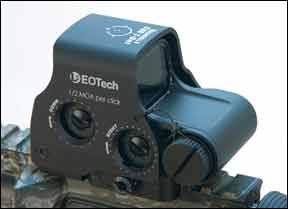
The M&P15 300 Whisper arrived with the same plastic pistol grip as the one we complained about on the Olympic Arms rifle, but the seams and edges were buffered and smooth. The Realtree APG coating helped seal its surface as well as giving the impression that the gun was one solid piece. A forward-assist plunger was included, and the camouflage pattern of the upper and lower end components matched. The trigger guard was not hinged for quick release, but it was enlarged. The Melonite-coated barrel maintained its full diameter over its 16-inch length, making it more rigid and adding to the M&Ps sleek profile.
From the bench we rediscovered the dual personality of the 300 Whisper. Ammunition is available in both subsonic and supersonic loads, and the cartridges were, in fact, designed to serve multiple purposes. It is generally considered to be accurate and effective out to approximately 200 yards. Naturally, the subsonic is the quieter of the two and offers less recoil. The M&P15 300 Whisper fires through a 1:7.5-inch barrel to accommodate both rounds, but we found significant differences in performance. First, the Hornady 208-grain A-Max ammunition was about twice as accurate on average as both the Hornady 110-grain V-Max and Remington 125-grain Accu-Tip rounds. Average group size from the 100-yard bench was 0.9 inches for the subsonic 208-grain rounds versus 1.6 inches and 2.0 inches across for the 110-grain and 125-grain rounds, respectively. The difference in power was also noticeable. With the lighter bullets flying as fast as 2300 to 2400 fps, they produced nearly three times the amount of muzzle energy as the 208-grain rounds. Muzzle energy computed to 1414 foot-pounds, 1507 foot-pounds, and 508 foot-pounds for the 110-grain, 125-grain, and 208-grain rounds respectively. Another big difference was point of impact. At 100 yards we had to increase elevation by as much as 9 MOA when changing from the supersonic to the subsonic ammunition. Nevertheless, the M&P15 300 Whisper ran reliably with all selections of ammunition.
Most shooters will choose one type of ammunition over another in the field. Switching back and forth between subsonic and supersonic ammunition would require a quality scope with enough adjustment to move back and forth between settings. Otherwise it could get pretty confusing. A scope with calibrated presets would be very helpful. The Ballistic Turret feature such as the one found on the Swarovski Optik Z5 3.5-18X44 LBT scope we used in our July 2011 and February 2011 rifle tests might be the ideal scope for the 300 Whisper enthusiast.
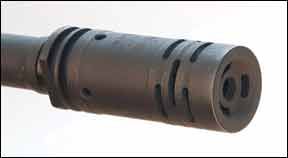
Naturally, we were very pleased with the sub-MOA accuracy of the M&P15 300 Whisper firing the 208-grain rounds and would like to have replicated this performance with more powerful ammunition. We think the faster, more powerful, rounds could be delivered with more accuracy simply by making the gun more controllable. One staff shooter complained that the seating of the buttstock was sloppy and interfered with setup. But other members of the staff thought it was little more than typical. Compared to the Olympic Arms rifle, the amount of play was minimal. We all agreed that the trigger could be lightened significantly without undue risk. At the very least it was inviting unnecessary fatigue. In our view these are minor issues compared to the amount of recoil we experienced shooting the supersonic rounds. Here is where we are reminded that the M&P15 300 Whisper is not necessarily the complete package beyond the addition of sights or a scope. This caliber was designed for use with a suppressor and with the proper can attached, recoil would be reduced. SSK Industries sells two different models specifically for 300 Whisper for $650.
One design simply screws on to the supplied threads, but the SSK Two-Point suppressor mounts over the barrel and minimizes additional length. If noise is not an issue, replacing the flash hider with an effective compensator like the new Muscle Comp ($140 from Tac-Grip.com) will tame even the most violent rounds stabilizing the gun and keeping the sights on track.
Our Team Said: We really liked the camouflage coating and the easy way it delivered the heaviest 30-caliber bullets. In our view, a compensator or suppressor would be an absolute necessity for shooting the supersonic rounds. But with or without a suppressor, this combination had something most ARs lack: Fun. Given the compatibility with other AR-15 lowers, buying the M&P15 300 Whisper upper might be the steal of the year for hunting and home defense.





























To damn much error and not found. The re-design of your site is a mess.